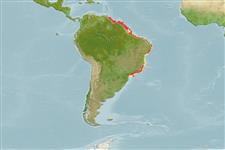>
Eupercaria/misc (Various families in series Eupercaria) >
Sciaenidae (Drums or croakers)
Etymology: Isopisthus: Greek, isos = equal + Greek, opisthe = behind (Ref. 45335).
More on author: Cuvier.
Environment: milieu / climate zone / depth range / distribution range
Ökologie
seewasser; brackwasser demersal; tiefenbereich 1 - 45 m (Ref. 3702). Tropical; 10°N - 27°S, 83°W - 34°W
Western Atlantic: Costa Rica to southern Brazil.
Length at first maturity / Size / Gewicht / Alter
Maturity: Lm 15.9 range ? - ? cm
Max length : 41.5 cm TL Männchen/unbestimmt; (Ref. 122735); common length : 20.0 cm TL Männchen/unbestimmt; (Ref. 3702); max. veröff. Gewicht: 740.00 g (Ref. 122735)
Rückenflossenstacheln (insgesamt) : 8 - 9; Rückenflossenweichstrahlen (insgesamt) : 19 - 20; Afterflossenstacheln: 2; Afterflossenweichstrahlen: 18 - 19. Silver grey, darker above. A diffuse black spot at pectoral-fin bases, fins pale to yellowish. Mouth large, strongly oblique, lower jaw projecting. Upper jaw with a pair of large canine-like teeth at tip. Chin without barbel or pores, lower margin of snout with 2 marginal pores. Two widely separated dorsal fins. Gas bladder with a pair of horn-like anterior appendages. Sagitta (large earstone) moderately thick and oval (Ref 51721).
Found in shallow coastal waters over sandy mud or soft mud bottoms (Ref. 3702). Feeds mainly on small shrimps (Ref. 3702). Important food fish.
Life cycle and mating behavior
Geschlechtsreife | Fortpflanzung | Ablaichen | Eier | Fecundity | Larven
Cervigón, F., 1993. Los peces marinos de Venezuela. Volume 2. Fundación Científica Los Roques, Caracas,Venezuela. 497 p. (Ref. 9626)
IUCN Rote Liste Status (Ref. 130435: Version 2024-1)
Bedrohung für Menschen
Harmless
Nutzung durch Menschen
Fischereien: weniger kommerziell; Köder: usually
Tools
Zusatzinformationen
Download XML
Internet Quellen
Estimates based on models
Preferred temperature (Ref.
123201): 24.8 - 27.9, mean 27.4 °C (based on 110 cells).
Phylogenetic diversity index (Ref.
82804): PD
50 = 0.7500 [Uniqueness, from 0.5 = low to 2.0 = high].
Bayesian length-weight: a=0.00794 (0.00727 - 0.00867), b=3.07 (3.05 - 3.09), in cm total length, based on LWR estimates for this species (Ref.
93245).
Trophic level (Ref.
69278): 4.0 ±0.4 se; based on diet studies.
Widerstandsfähigkeit (Ref.
120179): mittel, Verdopplung der Population dauert 1,4 - 4,4 Jahre. (Preliminary K or Fecundity.).
Fishing Vulnerability (Ref.
59153): Low to moderate vulnerability (32 of 100).
Nutrients (Ref.
124155): Calcium = 209 [116, 401] mg/100g; Iron = 1.19 [0.63, 2.15] mg/100g; Protein = 19.3 [18.1, 20.4] %; Omega3 = 0.269 [0.138, 0.466] g/100g; Selenium = 43.8 [22.6, 88.2] μg/100g; VitaminA = 23.3 [8.3, 72.3] μg/100g; Zinc = 1.4 [1.0, 2.0] mg/100g (wet weight);
